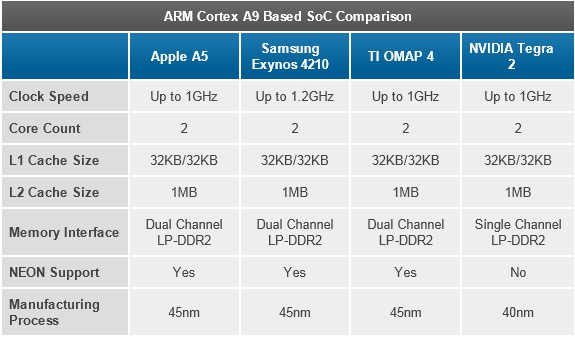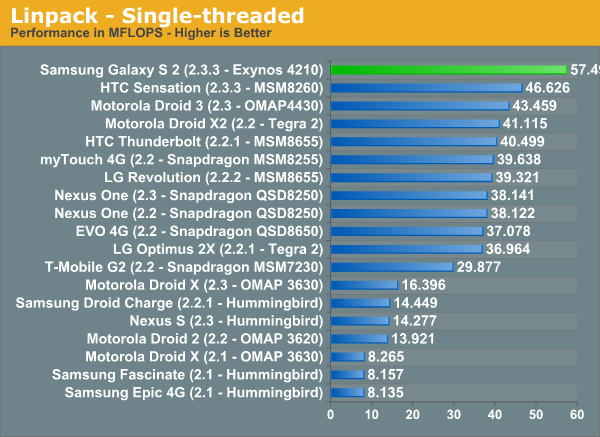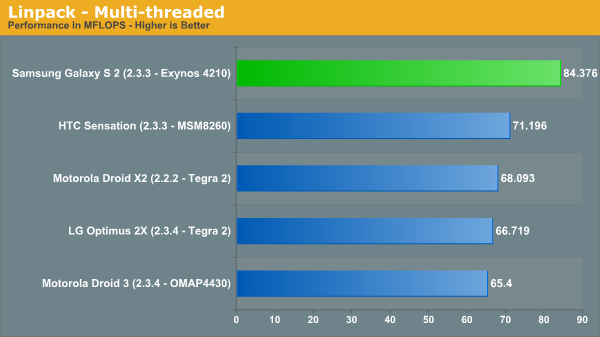
The Fastest Smartphone SoC Today: Samsung Exynos 4210
Samsung has been Apple"s sole application processor supplier since the release of the original iPhone. It"s unclear how much Samsung contributes to the design process, especially with later SoCs like the A4 and A5 carrying the Apple brand. It"s possible that Samsung is now no more than a manufacturing house for Apple.
Needless to say, the past few years of supplying SoCs for the iPhone and iPad have given Samsung a good idea of what the market wants from an application processor. We first got the hint that Samsung knew what it was up to with its Hummingbird SoC, used in the Galaxy S line of smartphones.
Hummingbird featured a 1GHz ARM Cortex A8 core and an Imagination Technologies PowerVR SGX 540 GPU. Although those specs don"t seem very impressive today, Hummingbird helped Samsung ship more Android smartphones than any of its competitors in 2010. At a high level, Hummingbird looked a lot like Apple"s A4 used in the iPad and iPhone 4. Its predecessor looked a lot like Apple"s 3rd generation SoC used in the iPhone 3GS.
Hummingbird"s successor however is Samsung"s first attempt at something different. This is the Exynos 4210 application processor:

Like most of its competitors, Samsung"s memory controller does allow for some flexibility when choosing memory types. In addition to LPDDR2, the Exynos 4210 supports standard DDR2 and DDR3. Maximum data rate is limited to 800MHz regardless of memory type.
Based on everything I"ve said thus far, the Exynos 4210 should be among the highest performing SoCs on the market today. It has the same clock for clock performance as an Apple A5, NVIDIA Tegra 2 and TI OMAP 4430. Samsung surpassed those designs by delivering a 20% higher operating frequency, which should be tangible in typical use.
To find out let"s turn to our CPU performance suite. We"ll start with our browser benchmarks: SunSpider and BrowserMark:



A clock speed advantage today is nice but it"s something that Samsung"s competitors will be able to deliver in the not too distant future. Where Samsung chose to really differentiate itself was in the graphics department. The Exynos 4210 uses ARM"s Mali-400 MP4 GPU.
Shipping in smartphones today we have GPUs from three vendors: Qualcomm (Adreno), Imagination Technologies (PowerVR SGX) and NVIDIA (GeForce). Of those vendors, only Qualcomm and NVIDIA produce SoCs - Imagination simply licenses its technology to SoC vendors.
Both Apple and Intel hold significant amounts of Imagination stock, presumably to protect against an eager SoC vendor from taking control of the company.
ARM also offers GPU IP in addition to its CPU designs, however we"ve seen very little uptake until now. Before we get to Mali"s architecture, we need to talk a bit about the different types of GPUs on the market today.
мӮјм„ұ м—‘мӢңл…ёмҠӨмһ…лӢҲлӢӨ.

The Fastest Smartphone SoC Today: Samsung Exynos 4210
Samsung has been AppleВҘ"s sole application processor supplier since the release of the original iPhone. ItВҘ"s unclear how much Samsung contributes to the design process, especially with later SoCs like the A4 and A5 carrying the Apple brand. ItВҘ"s possible that Samsung is now no more than a manufacturing house for Apple.
Needless to say, the past few years of supplying SoCs for the iPhone and iPad have given Samsung a good idea of what the market wants from an application processor. We first got the hint that Samsung knew what it was up to with its Hummingbird SoC, used in the Galaxy S line of smartphones.
Hummingbird featured a 1GHz ARM Cortex A8 core and an Imagination Technologies PowerVR SGX 540 GPU. Although those specs donВҘ"t seem very impressive today, Hummingbird helped Samsung ship more Android smartphones than any of its competitors in 2010. At a high level, Hummingbird looked a lot like AppleВҘ"s A4 used in the iPad and iPhone 4. Its predecessor looked a lot like AppleВҘ"s 3rd generation SoC used in the iPhone 3GS.
HummingbirdВҘ"s successor however is SamsungВҘ"s first attempt at something different. This is the Exynos 4210 application processor:

Like most of its competitors, SamsungВҘ"s memory controller does allow for some flexibility when choosing memory types. In addition to LPDDR2, the Exynos 4210 supports standard DDR2 and DDR3. Maximum data rate is limited to 800MHz regardless of memory type.
Based on everything IВҘ"ve said thus far, the Exynos 4210 should be among the highest performing SoCs on the market today. It has the same clock for clock performance as an Apple A5, NVIDIA Tegra 2 and TI OMAP 4430. Samsung surpassed those designs by delivering a 20% higher operating frequency, which should be tangible in typical use.
To find out letВҘ"s turn to our CPU performance suite. WeВҘ"ll start with our browser benchmarks: SunSpider and BrowserMark:



A clock speed advantage today is nice but itВҘ"s something that SamsungВҘ"s competitors will be able to deliver in the not too distant future. Where Samsung chose to really differentiate itself was in the graphics department. The Exynos 4210 uses ARMВҘ"s Mali-400 MP4 GPU.
Shipping in smartphones today we have GPUs from three vendors: Qualcomm (Adreno), Imagination Technologies (PowerVR SGX) and NVIDIA (GeForce). Of those vendors, only Qualcomm and NVIDIA produce SoCs - Imagination simply licenses its technology to SoC vendors.
Both Apple and Intel hold significant amounts of Imagination stock, presumably to protect against an eager SoC vendor from taking control of the company.
ARM also offers GPU IP in addition to its CPU designs, however weВҘ"ve seen very little uptake until now. Before we get to MaliВҘ"s architecture, we need to talk a bit about the different types of GPUs on the market today.
дёүжҳҹгӮЁгғғгӮҜгӮ·гғҺвҲ’гӮ№гҒ§гҒҷ.
����������

